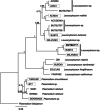First assessment of the prevalence of haemosporidian infections in Accipitriformes raptors in Greece
- PMID: 39777575
- PMCID: PMC11706923
- DOI: 10.1007/s00436-024-08445-1
First assessment of the prevalence of haemosporidian infections in Accipitriformes raptors in Greece
Abstract
Haemosporidians, a group of vector-borne parasites that parasitize the blood cells and internal organs of various animal species, are reported to cause severe pathology in raptors. Species belonging to the genera Plasmodium, Haemoproteus and Leucocytozoon are the ones of greatest wildlife importance. The common buzzard (Buteo buteo) and the Eurasian sparrowhawk (Accipiter nisus) are the most numerous raptor species in Europe. Reliable data is lacking for many raptor species in Greece. The aim of this study was to assess, for the first time, the prevalence and geographical distribution of haemosporidian infection (mainly Leucocytozoon and Plasmodium) in these two avian species in Greece, in correlation with the risk factors of age and sex. In total, 62 common buzzards and 26 Eurasian sparrowhawks were included in this study, all being admitted for treatment at a Greek Wildlife Rehabilitation Center. Blood samples were collected and microscopical analysis was performed after staining blood smears with Giemsa. DNA was extracted from each sample and a fraction of the mitochondrial cytochrome b gene was amplified by a nested PCR protocol. All positive samples were subjected to sequencing. Total prevalence of haemosporidian infection by morphological and molecular examination was 59% and 73.9%, respectively. Binary logistic regression was carried out. The most prevalent infection was by Leucocytozoon spp. Most of the samples had mixed infections. The isolated genetic lineages of Leucocytozoon spp. were BUBT2, BUBT3, MILVUS01, ACNI1, BUBO01 and MILANS04. The detected genetic lineages of Plasmodium spp. were TURDUS1, BT7 and DONANA02. A new genetic lineage, BUTBUT17, was also identified.
Keywords: Leucocytozoon; Plasmodium; Greece; Haemosporidians; Raptors.
© 2025. The Author(s).
Conflict of interest statement
Declarations. Ethics approval: Ethical approval was obtained by the Ethics Committee of the Aristotle University of Thessaloniki (32778/2021). Collection of blood samples was carried out by veterinarians adhering to the regulations and guidelines on animal husbandry and welfare. The birds were admitted to ANIMA, Association for Wildlife Care and Protection which is a nationally and legally recognised non-profit association for the hospitalization and rehabilitation of wild animals. Consent to participate: All authors consent to participate in this publication. Consent for publication: All authors consent to publish the manuscript. Competing interests: The authors declare no competing interests. Clinical trial number: Not applicable.
Figures


Similar articles
-
MOLECULAR SURVEY OF HAEMOSPORIDIAN PARASITES IN HAWKS, FALCONS, AND OWLS (ACCIPITRIFORMES, FALCONIFORMES, STRIGIFORMES) FROM MINNESOTA AND NORTH DAKOTA, WITH REMARKS ON THE PHYLOGENETIC RELATIONSHIPS OF HAEMOSPORIDIANS IN NORTH AMERICAN RAPTORS.J Parasitol. 2025 May 1;111(3):299-314. doi: 10.1645/25-16. J Parasitol. 2025. PMID: 40494546
-
Blood parasites in northern goshawk (Accipiter gentilis) with an emphasis to Leucocytozoon toddi.Parasitol Res. 2016 Jan;115(1):263-70. doi: 10.1007/s00436-015-4743-1. Epub 2015 Sep 14. Parasitol Res. 2016. PMID: 26365666
-
Evidence for cryptic speciation of Leucocytozoon spp. (Haemosporida, Leucocytozoidae) in diurnal raptors.J Parasitol. 2006 Apr;92(2):375-9. doi: 10.1645/GE-656R.1. J Parasitol. 2006. PMID: 16729697
-
Trypanosomes and haemosporidia in the buzzard (Buteo buteo) and sparrowhawk (Accipiter nisus): factors affecting the prevalence of parasites.Parasitol Res. 2015 Feb;114(2):551-60. doi: 10.1007/s00436-014-4217-x. Epub 2014 Nov 19. Parasitol Res. 2015. PMID: 25403377
-
Exo-erythrocytic development of avian malaria and related haemosporidian parasites.Malar J. 2017 Mar 3;16(1):101. doi: 10.1186/s12936-017-1746-7. Malar J. 2017. PMID: 28253926 Free PMC article. Review.
Cited by
-
Avian Haemosporidian Parasites in Three Wild Columbids from Germany.Microorganisms. 2025 Jun 4;13(6):1305. doi: 10.3390/microorganisms13061305. Microorganisms. 2025. PMID: 40572194 Free PMC article.
References
-
- Atkinson CT, Samuel MD (2010) Avian malaria Plasmodium relictum in native Hawaiian forest birds: epizootiology and demographic impacts on àapapane Himatione sanguinea. J Avian Biol 41:357–366. 10.1111/j.1600-048X.2009.04915.x
-
- Beadell JS, Gering E, Austin J et al (2004) Prevalence and differential host-specificity of two avian blood parasite genera in the Australo-Papuan region. Mol Ecol 13:3829–3844. 10.1111/j.1365-294X.2004.02363.x - PubMed
-
- Bensch S, Hellgren O, PÉrez-Tris J (2009) MalAvi: a public database of malaria parasites and related haemosporidians in avian hosts based on mitochondrial cytochrome b lineages. Mol Ecol Resour 9:1353–1358.10.1111/j.1755-0998.2009.02692.x - PubMed
-
- Bernotiene R, Palinauskas V, Iezhova T et al (2016) Avian haemosporidian parasites (Haemosporida): a comparative analysis of different polymerase chain reaction assays in detection of mixed infections. Exp Parasitol 163:31–37. 10.1016/j.exppara.2016.01.009 - PubMed
MeSH terms
Substances
LinkOut - more resources
Full Text Sources
Miscellaneous

